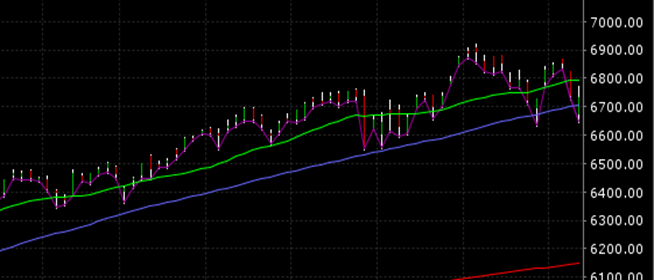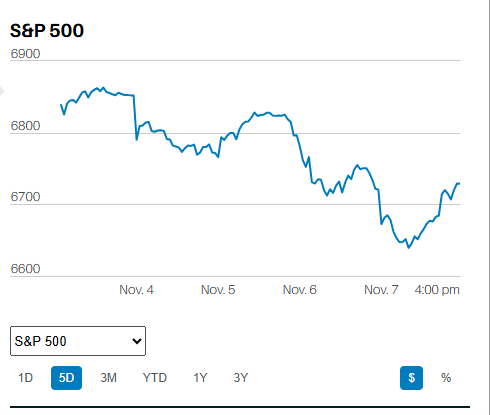Social Security is longevity insurance

Market Update
The S&P 500 rose 3.6% last week to finish at 4067.36. The Nasdaq rose 4.1% and the Dow Jones 2.7%. All three indices fell three weeks in a row before last week’s gains. Fundamentals didn’t change last week. The Fed is likely to hike 0.75% later this month. Earnings estimates are still falling. Inflation is still well above desired levels. Sellers most likely simply ran out of things to sell after three weeks of ugly. The bounce off Fibonacci support provided an excuse to cover shorts and do some bottom fishing.
We wrote last week that the S&P 500 had retraced 62.8% of its rally from the June low and needed to hold support. Otherwise, the odds of an immediate test of the 3636 June low was likely. The S&P did hold. It bottomed at 3903.65 on Thursday 1 September and 3906.21 on Friday 2 September. The S&P bottomed at 3886.75 on Tuesday 6 September but closed at 3908.19, above the prior two trading day lows. Holding the Fibonacci number and closing above the prior two day’s lows was enough for sellers to stop and the buyers to start.
The S&P bottomed at 3906.03 on Wednesday and took off from there. It tacked on 161 points or 4.1% during the last three days of trading. We will still probably see a test of the 3636 bear market low before year-end. The market has bought itself some time though. A push higher toward 4200 is more likely in the next week or two than an immediate continuation of the decline. We wrote last week, “Earnings estimates are falling. The Federal Reserve is tightening, and the technical picture is negative. The path of least resistance is still down.” All still true, but markets rarely move in straight lines.
Economic Indicators
There was little in the way of economic news last week. Certainly nothing major that would move markets. The ISM services index was 56.9% in August up from 56.7% the prior month. The forecast was for 55.5% which made it a pleasant surprise. Otherwise, there wasn’t much to point at to clarify the current situation. The economy is still slowing but by how much is the question. Inflation is still far too high but appears to have peaked. How quickly it will fall is the worry. The probability of a 0.75% rate hike later this month rose to 90%. The two-year Treasury is at 3.58%. It is indicating that the bond market expects the Fed funds rate to rise another 1.25% in the near term. In fact, many forecasters expect the Fed to follow the September 0.75% hike with a hike of 0.5% in November and another 0.25% in December. Those additional hikes would put the Fed funds rate at 3.75%-4.0%. It is currently 2.25%-2.50%. The two-year will likely continue to rise closer to 3.75% by end of year, tracking the expected rise in the Fed funds rate.
Meanwhile, the 10-year Treasury is at 3.32%. It should rise along with the two-year even with inflation having peaked. A two-year Treasury rate of 3.75% would likely put the 10-year at 3.6% or so in a tightening environment. The yield curve isn’t going to steepen until the bond market believes that the Federal Reserve is done tightening. It will also depend on the bond market’s view of inflation’s path over the next few years. The five-year breakeven is currently 2.51% and has been falling. The 10-year breakeven is 2.42%. Norwood Economics continues to like Inflation Protected bonds. Inflation is likely to average at least 3% over the next five to ten years, well above the breakeven rate.
Pushing inflation below 4% is going to take some time, according to Doug Peta, chief U.S. investment strategist at BCA Research. He sees inflation falling quickly to 4% due to cyclical factors. He thinks it will take a federal funds rate above 4% for some time to move the inflation rate to 2% though. Peta believes the stock and bond markets aren’t pricing in that reality yet. Meanwhile, the CPI is expected to show an 8.1% rise year-over -year, down from 8.5%. The core number is expected to rise to 6.1% from 5.9%. The CPI report comes out this week. The environment heading into the last 3 ½ months of the year promises plenty of volatility.
Social Security is Here to Stay
Barron’s had two articles on social security last week. The main takeaway is that social security isn’t going away. Changes do need to be made but they are unlikely to affect anyone older than 45 years of age. That estimate is based on it taking Congress a decade to act. Also, the likelihood that no one within 10 years of full retirement age will be affected when Congress does act.
One of the most likely changes will be an increase in the social security full retirement age. It is currently 67 and will probably be increased to 69 years of age. The increase is the equivalent of a 13% cut in lifetime benefits. Unwelcome but hardly fatal. It means people will need to save more to make up for the lost income. A 35-year-old earning $100,000 a year would need to save an additional, inflation-adjusted $33 a week over the course of their career to make up for a 20% lifetime reduction in social security benefits, according to HealthView Services. HealthView provides retirement healthcare cost data and planning tools for the financial services industry.
Barron’s also weighed in on the timing decision. Most Americans take social security at age 62. It is a mistake. They are locking themselves into an almost 30% smaller check. Waiting until 70 years of age gets them 124% of the full retirement age benefit. People will receive 77% more by waiting until age 70 rather than taking social security at age 62. Breakeven is around 82 years of age.
Most Americans don’t wait until age 70 even though they are likely to live past 82 years of age. They grab the money as soon as they can for a variety of reasons. One is that they underestimate how long they are likely to live. Many will point to their parent's age at death. Genetics accounts for less than 7% of longevity. Others don’t understand life expectancy. People who are 65 have a life expectancy in their 80s, according to the National Center for Health Statistics.
All of which is beside the most important point: social security is longevity insurance. The risk of “losing” some social security benefits by dying early is far outweighed by social security’s role as longevity insurance. The true risk for retirees is outliving their assets. Your larger social security check represents insurance against outliving your assets. The cost of that insurance is most often negative in that most people don’t pay it. Instead, they live past 82 years of age and collect tens of thousands more in social security than otherwise. Quality of life will be greater for those retirees who win the lottery and live well into their 90s if they wait until 70 to start collecting social security.
Regards,
Christopher R Norwood, CFA
Chief Market Strategist











